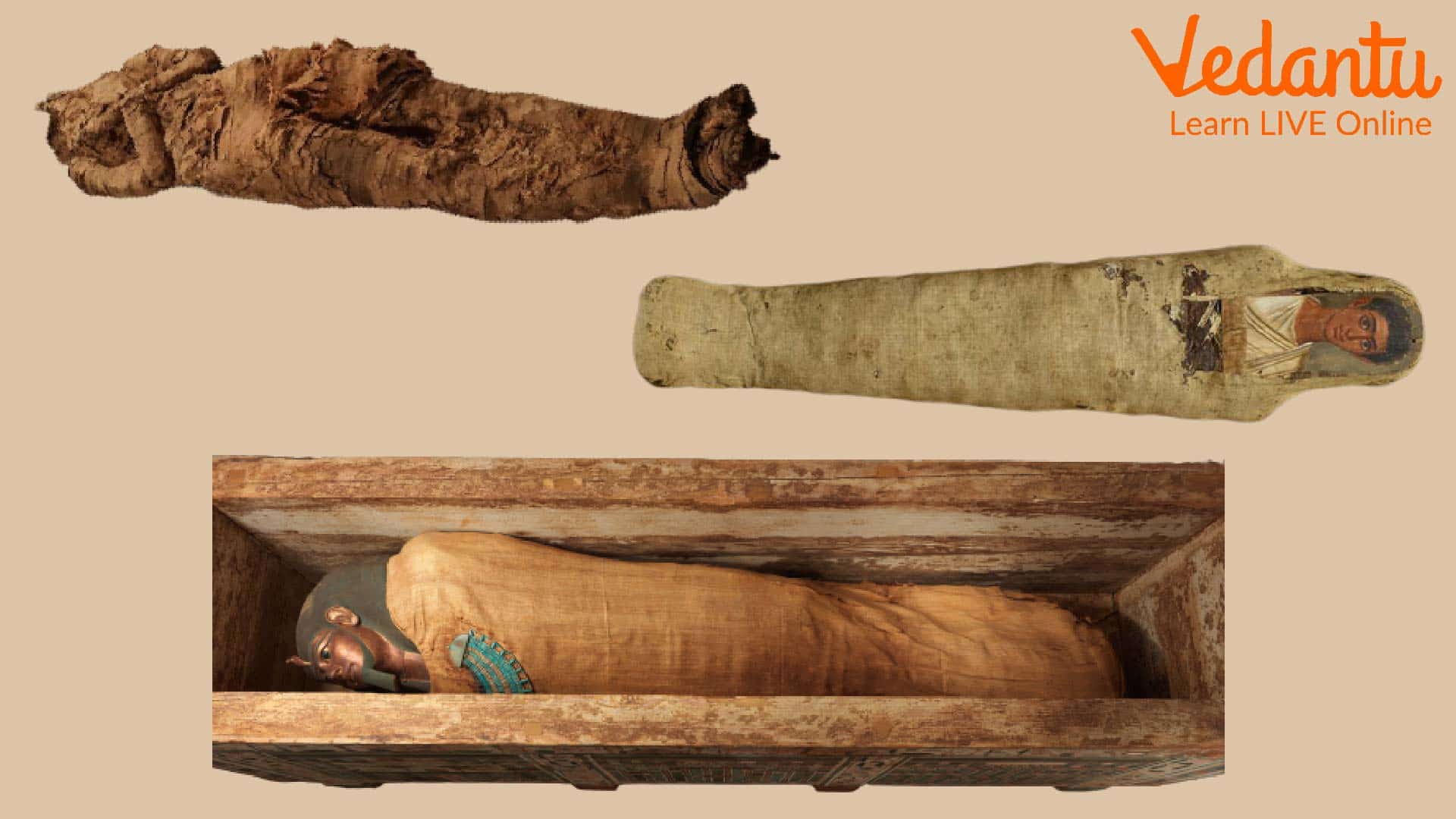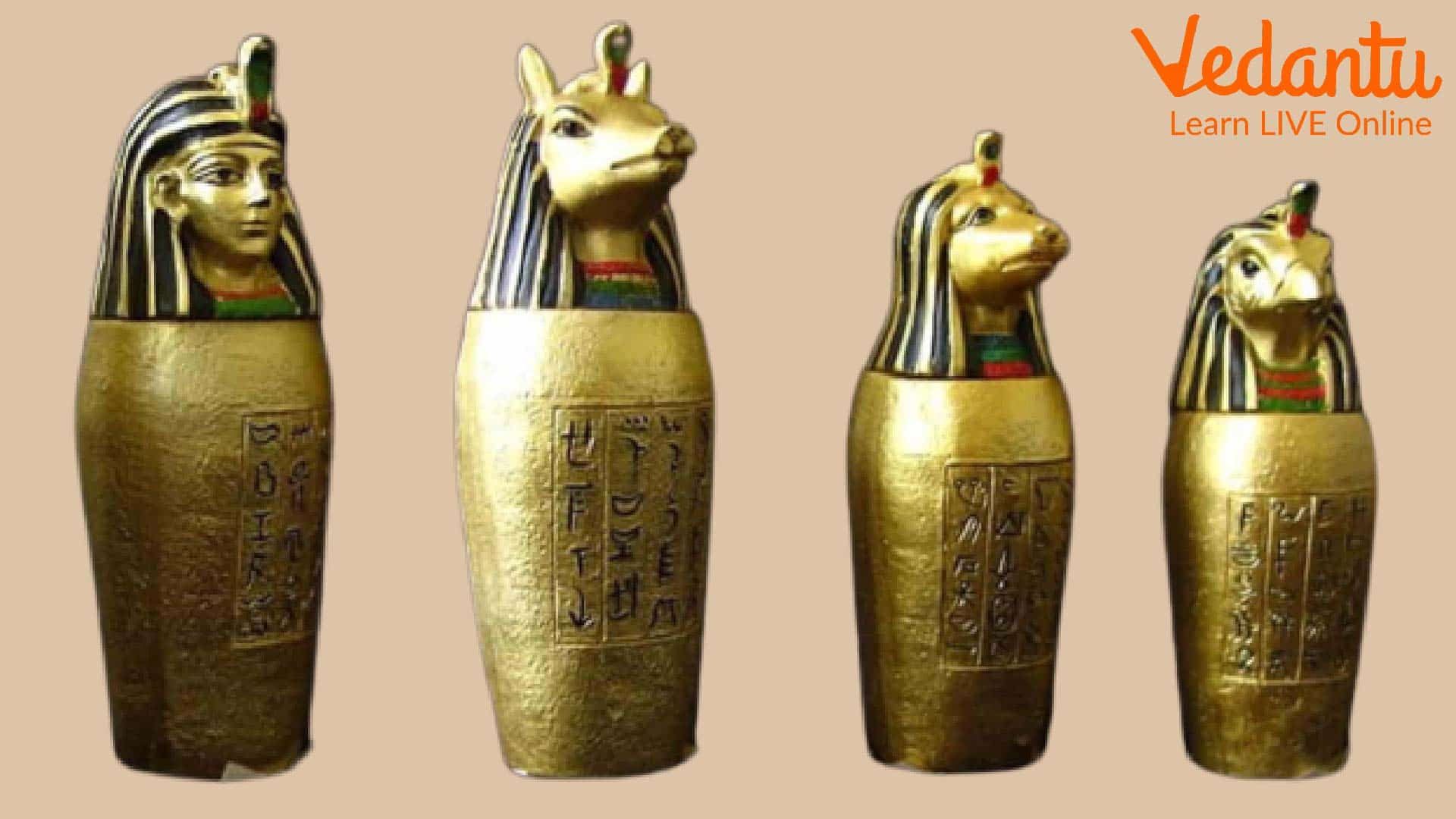What is a Mummy?
A mummy is a dead human body and, in some cases dead animal body that has either accidentally dried and decayed due to extreme weather conditions or intentionally preserved through chemical exposure. It can be classified into two categories, spontaneous and anthropogenic. Mummies formed due to random exposure to very cold, humid weather conditions, in the absence of air, fall under the spontaneous category. While those deliberately created by human beings mostly for religious and spiritual reasons using various chemical compositions come under the anthropogenic category.
The word ‘mummy’ is derived from the Arabic word ‘mummiya’ meaning bitumen or tar. In ancient times, preserving the dead bodies of humans and animals was widely spread among various societies, commonly known as mummification. Read through this article to know more about mummies and how were mummies made in detail.

Wrapped Up Mummy
History Behind the Egyptian Mummy
Egyptian mummies were created following certain spiritual beliefs. Over millions of years ago, the ancient Egyptians considered that every living being possessed a vital force or spirit, known as ‘ka’ that parted from the living body after death. It also has a human-headed bird expressing the mobility of the soul after death, known as ‘ba’. Upon death, ‘ka,’ that was still consuming the individual's spiritual essence would require food offerings.
On the other hand, ‘ba’, resembling a set of spiritual aspects unique to an individual, would remain attached to a body even after death and return every night to attain new life. Thus, Egyptians preserved the human body after death to keep the soul safe through the process of mummification. Although the Pharaohs and other rich influential people of Egyptian society elaborately performed this practice, it built the foundation of Egyptian religion.
Process of Mummification
Mummification is called the process of embalming or continuous drying of the dead body to preserve it after death. In ancient times, mummification was an omnipresent and honoured tradition, inculcated with profound religious effectiveness and mostly performed by trained professionals. It was the practice of securing the soul of an individual upon death in the existential belief of the afterlife.
Though the process of mummification was widely practised among various societies and cultures, the most commonly known as the Egyptian society, followed by the Chinese, the Guanches, and a few more ancient societies. The entire mummification technique in ancient Egypt underwent a gruesome and lengthy process. Here is a step-wise detailed description of mummification and how are mummies preserved:
Step 1: Announcing the Death
When someone from the family died, a messenger was sent out to inform the crowd of the death. The family of the dead made arrangements to mourn for the ceremony and preparation of the body. This entire ritual was essential to the Egyptians as they believed that once the soul left the body upon death, to attain eternity, it was important to unite the body and the soul after the burial.
Step 2: Embalming and Purifying the Body
During the embalming stage, the Egyptians believed that the body needed to be purified. So, it was brought carefully into a tent known as ‘ibu’. The embalmers then thoroughly washed the body in good-smelling palm wine and rinsed it with water from the river Nile.
Step 3: Discarding the Brain from the Dead Body
In ancient days, the brain was not considered a useful organ as its functions were unknown to most people. Hence, it was discarded in a very unhealthy and thoughtless manner. The embalmers inserted a special hooked rod through the nostrils directly to the skull, thus, breaking the brain apart to make it drain out. Bits of brain tissue were then taken out from the nose and liquified by dissolving in water.
Step 4: Removal of the Internal Organs
To remove the internal organs from the body, the embalmers had to make a small incision in the left side of the stomach. The stomach, intestines, liver and lungs were taken out one by one from the body. These were then washed carefully and packed in natron, a type of salt, to absorb moisture. Each of these organs was stored in a small coffin-like container called a Canopic jar.
All four Canopic jars were covered with lids representing the Four Sons of Horus. Hapy, the baboon-headed jar, protected the lungs, Imset, the human-headed jar, protected the liver, Duamutef, the jackal-headed jar, guarded the stomach and Qebehsenuef, the falcon-headed jar, looked after the intestines.
Although the internal organs were removed from the body, the heart was left untouched as it was considered the epicentre of intelligence that would be required in the afterlife.

Canopic Jars Representing the four Sons of Horus
Step 5: Drying Out the Body
Once the internal organs were removed, the body was placed carefully on a tilted slab and then stuffed and covered with natron to absorb all the moisture, thus, preventing the body from rotting. The soaked moisture from the body was collected in a bowl and then left to dry out for almost forty days.
Step 6: Stuffing the Body
After forty long days of drying up the body, it was again washed in Nile water and oil was applied to maintain the skin's elasticity. All the natron was then scooped out thoroughly. The body was then stuffed with sawdust and linen cloth to make it look lifelike.
Step 7: Wrapping up the Body and Adding Amulets
The process of wrapping up the body started by placing the Eye of Horus over the abdominal slit to let the body be blessed. At first, the head and the neck were wrapped, followed by each finger and toe. Embalmers gathered thousands of yards of linen for wrapping. In between the layers of linen, charms called amulets and papyrus were placed to protect the body against evil while on its journey to the afterlife.
Finally, a type of glue was applied to hold everything together. Priests performed rituals like reciting prayers and writing on the linen layers to protect the body.
Step 8: Final Decoration
In the final step, the wrapped-up mummy was well decorated. Embalmers used artificial eyes and various cosmetics on the mummy’s face. They even covered the head with a portrait mask to help the dead person's soul easily identify their own body. Finally, they placed the mummy carefully in a decorated coffin.
Step 9: The Last Ritual
As part of the last ritual, members of the dead person’s family and friends would walk through the entire town and cry out loud while on their way to the tomb. It was believed that the chances of the dead attaining the afterlife increase depending on the increased number of mourners. On reaching the tomb, the Opening of the Mouth ceremony took place before placing the coffin in the tomb.
The priests would touch different parts of the mummy’s face while the family members recited some spells. This ceremony helped the mummy to see, hear, eat and move into the afterlife.
Conclusion
To summarize, it could be said that a mummy is a human or animal's body that has been either preserved after death or dried up due to extreme cold weather and lack of air. Ancient Egyptian society carried out the mummification process by deliberately embalming or drying flesh to let the dead person’s soul move to the afterlife and attain eternity.







